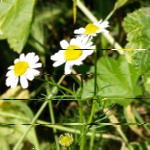Marticaria chamomilla
Wild chamomile, scented mayweed Ηαμομήλι

Compositae - daisy family Dicot.
Marticaria chamomilla
Wild chamomile, scented mayweed Ηαμομήλι

Compositae - daisy family Dicot.
Wild chamomile is a familiar site in Skopelos in springtime. It often covers the bare ground at the entrance to fields and waste land with small daisy like flowers with feathery leaves. It tends to fill the space available for it. When crushed the leaves give off the characteristic aroma of chamomile often likened to apples. The Greek name translates to earth apple. It's value as a soothing tea and herbal medicine has been recognised since ancient times (see below).


Herbal Chamomile
Chamomile is well known as a fragrant, soothing tea. The two commonest varieties used for this are German chamomile ( M. chamomilla) and Roman chamomile (Chamaemelum nobile). It is gathered from the wild and is grown as a commercial crop by the monks of Mount Athos. It's medicinal properties have been recognized since ancient times and the herb was used by the Egyptians, the Greeks and the Romans for a wide variety of disorders. It's value was recognized by the first century physician Dioscorides and described in De Materia Medica. The herb has been recommended as a soporific, for childhood colic and menstrual cramps and many anther ailments. It is also used to bathe inflamed skin and eyes but unfortunately may cause an allergic reaction in sensitive individuals and make worse the problem it has been used to help.

